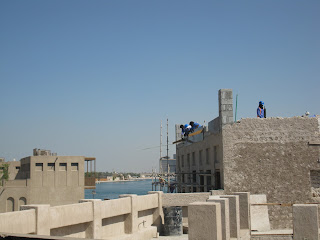I used to wonder what it was like, whenever I passed by the numerous brick villas in Dubai. Thus, when I found out that the residence of Sheikh Saeed Al Maktoum was opened to the public, I was elated!
Before I venture any further, I think that the most proper thing of all would be to introduce Sheikh Saeed Al Maktoum. Born at the end of the 19th century, year 1878, he began ruling in 1912. He was simple, religious and a true Arab to the core. He favourite sport was falconry and hunting. Guess what? He owned a date plantation too!
During his reign, the pearl industry thrived and Dubai was established as one of the main ports in the Gulf. He was far-sighted, transforming Dubai into a modern city. He ruled for 46 years, and died the year my parents were born, in 1958. He lived 'til a ripe old age of 80.
 |
| Houses were huddled closely, with high population density |
Ahhh... Dubai was prosperous, even before the discovery of black gold. But have you ever wondered, how did the city look like before its skyline was dotted with high rise buildings? As I walked through the creek and museums, I learnt about its humble beginnings. It started out like any other cities in all civilizations. It began by the river, where men could easily fish, farm and trade.
At that time, of course, there were rich people and poor people. Rich people or rulers lived in grand houses and large compounds, whereas the commoners or poorer ones lived in wooden huts and palm leave roofs, a vast contrast indeed.
 |
| Commoner's Residence |
 |
The Sheikh's residence was very grand. Why? Because it was built over a large compound. Consisting of around 1100 square meters (about 12000 sqft), Sheikh Makhtoum's villa consists of 2 floors with a spacious courtyard in the middle. Each room has a living room, bathroom, verandah and summer room.
While the commoner's house was made of wood, the Sheikh's house was constructed from limestone!
As a petroleum engineer, all I know is limestones are they're excellent oil reservoirs! I never thought that in the past, people used limestones with embedded fossils to build their houses too! Wouldn't it dissolve, form holes or caves, staglagtites and staglamites? I guess these chemical and dissolution processes take a long time. By the time these natural structures formed, its occupants would have been long gone.
The Sheikh's house has to be decorated too, to distinguish it from the rest of the other houses. So, here, the house is unique because it has a distinctive floral designs which are extremely geometrical, using only gypsum and charcoal! (My first thought as I read this was: How did the charcoal last for so long? Wouldn't the colour fade? or its tiny particles risk being blown off the surface by strong winds?)
Oh! Have you noticed that both kinds of houses contained tall wind towers too? They're square and hollow, just like chimneys. The only difference is, it brings wind into the house, instead of polluting the air with thick, black smoke puffs. Being more environmental friendly, it sieves out light sand particles, increases ventilation and even removes bird waste!
I used to wonder why a ruler's house ought to be high on the mountains, or taller than anybody else's house. Why? When I stepped out onto the roof, I finally found the answer. It's because, as a ruler, you'd want to see the lands your own, the activities of your people, to enjoy the beauty of your own homeland. What better way than to locate it right in the heart of all activities, and make it the tallest building in the vicinity of hustle and bustle of the town?
Standing on the roof top of Sheikh Makhtoum's house, I realized why kings always want to conquer more lands and have many loyal subjects under them. Imagine if I were the ruler of this land, I would not only want it to prosper, I'd also like to the boundaries of my country to extend far and wide. The more subjects I have, the more taxes I'll get! No wonder people went to wars all the time. You can't blame them. The idea of having more is very addictive.
Today, Dubai is very different from before. Emiratis of the previous generation miss those quiet and peaceful times, when people still experienced face to face interactions, and visited each other physically. (Read all about it here.)






No comments:
Post a Comment